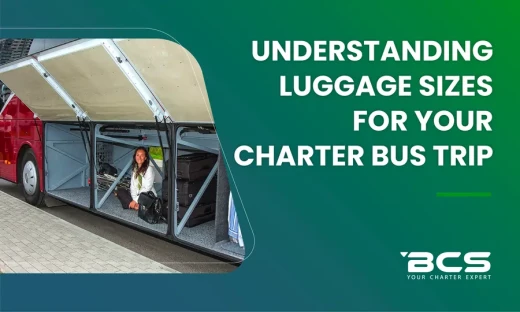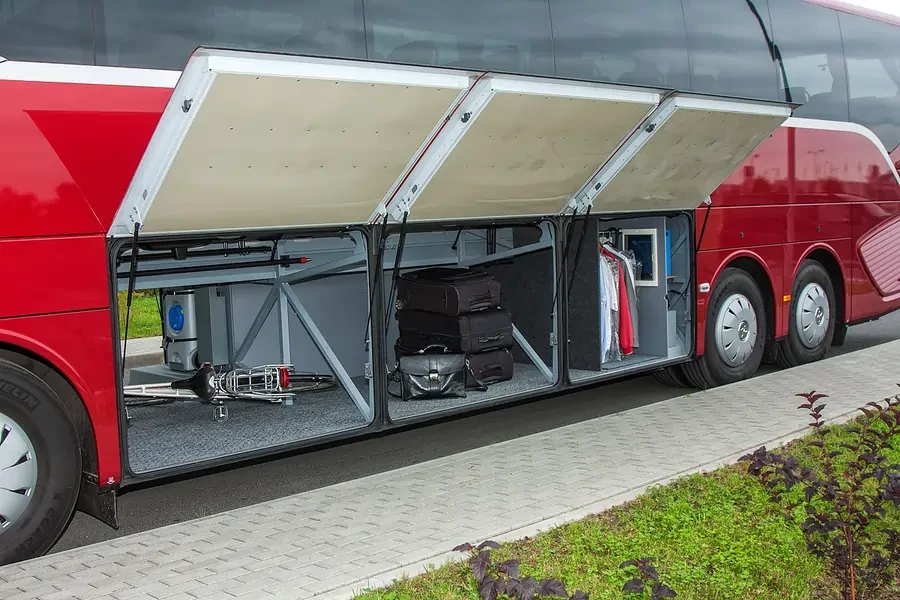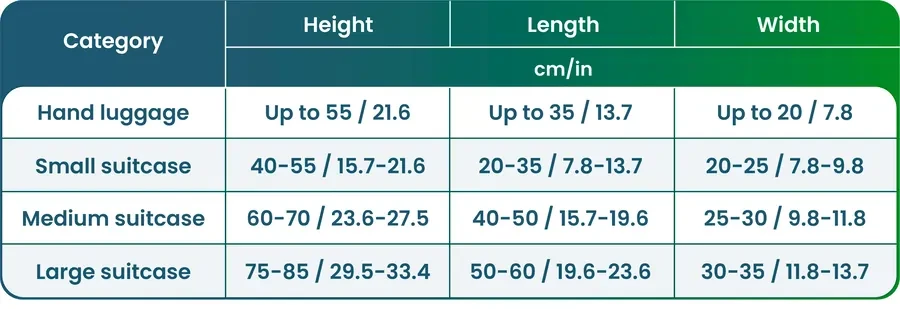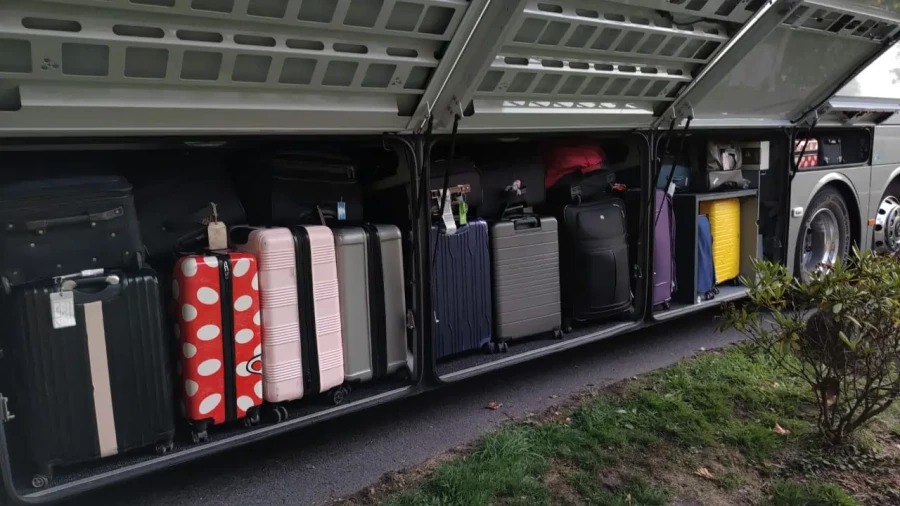How Much Luggage Can I Bring on a Charter Bus?



A Guide to US & EU Luggage Rules
While group travel is often messy, one cannot deny that it also brings tons of fun and forges strong bonds. Whether you are traveling for fun, tourism, or work, traveling together has the potential to be awesome in many ways. However, travelers cannot only savor the excitement of planning such journeys; rational aspects, such as managing their luggage, causes confusion more often than not.
Planning what to pack is especially difficult for people traveling abroad, since they often use several means of transportation: long-haul flights, charter buses, taxis and so forth. Each country and even each company sets different rules, so it can be difficult to pack in a way that will not bring negative surprises later on. At BCS Bus, we decided to write this guide precisely to help you with such a burden.
This guide starts with the basics, such as understanding typical suitcase sizes. Then, it mentions the most common cause of confusion: differences between Europe and the US when it comes to those sizes. Last, but not least, it provides several useful tips for you and your travel group to find how to pack without having problems in the future. We wish you a smooth and pleasant travel experience!

Understanding Luggage: A Traveler's Guide to Sizes
We believe that the first step should be to establish a common ground. Travel service providers and suitcase manufacturers often categorize bags and suitcases according to the rules we present here:
-
Hand luggage: also named carry-on, it is made to fit into a cabin's overhead bin or under the seats. Besides small suitcases, this category includes backpacks, purses, and duffel bags.
-
Small suitcases: They are similar in size to the hand luggage mentioned above but refer to wheeled suitcases specifically, which are ideal for short trips and/or weekend getaways.
-
Medium suitcases: They offer a more substantial room, which makes them suitable for longer journeys and/or when you need to pack bulkier items such as winter clothing.
-
Large suitcases: They are recommended for extended trips, cold destinations, or when you need to transport a significant volume of outfits, shoes, or electronic devices.
The approximate measurements for each of those suitcase categories are presented below. Keep in mind that these dimensions are general market ranges; the actual limits will depend on the carrier. Also, all measurements include handles, wheels, and any other extensions the suitcase might have. We are going to use those names and measurements on the following topics of this luggage guide.

The Crucial Difference: Charter Bus vs. Airline Luggage Realities
Now that we have gone through the basics, we can delve into the core issue: differences between service providers when it comes to luggage dimension limits, and problems that arise from them. There are differences between regions (US and Europe, mostly), and service providers (airlines and bus companies). But there is nothing to worry about: we have covered everything in this article.
EU vs. USA Differences in Luggage Limits
In the United States, long-haul travel is typically done by air. While most airplanes there are huge, they still have a limited cargo room. As a result, domestic airlines tend to impose dimension limits rather than capping suitcase weight. For example, the weight limits for checked luggage can go as far as 70 lbs. (32 kg) for standard suitcases. That is quite large considering what we are going to see.
When it comes to the European Union, it is more common to travel by train; there are also low-cost airlines for people on a budget. In both cases, there are stricter weight limits to follow: carry-ons at 22 lbs. (10 kg) and checked suitcases at 50 lbs. (23 kg). Europeans tend to pack lighter when going on a trip, so it is easy to understand why trans-continental travel can be confusing in this regard.
Important Note: The worst possibility is when US travelers pack according to their local rules and fly to Europe; their luggage is considered oversized everywhere at their destination, which brings extra cost and stress.
Luggage Limits Compare: US Airlines vs. Charter Buses
As mentioned above, US airlines are quite generous about luggage weight; they tend to limit them by their dimensions. That is applicable even to carry-on bags; the general rule is that the passenger must be able to lift that bag into the overhead bin on their own. On the other hand, charter bus services in Europe are much more limited when it comes to carrying luggage; both volume and weight are restricted.
Modern three-axle coaches, for instance, offer a cargo volume of 9.6 m³ to 14.3 m³. However, that volume can be filled with 4 metric tons (8,200 lbs.), which is a big part of the Gross Vehicle Weight (GVW) limit it must comply with. As you can see, even a few oversized or very heavy bags can take a lot of the available cargo space. The limit per passenger stays around 55 lbs. (25 kg) per suitcase.
In this case, the common problem is that travelers fly with numerous and/or heavy bags, then face much stricter limits when boarding a charter bus in order to complete the trip to their destination.

Charter Bus Luggage Capacity: What You Need to Know
At BCS Bus we know that no one wants to reach the last part of their trip, when people are often exhausted, finding out that transporting their bags requires extra fees all of a sudden, or is not even possible. We have already shown the main rule of thumb: luggage restrictions are often more lax in the US than in Europe. Now, we are going to provide some other tips which you might find helpful.
Bus Luggage Capacity: Example of a 50-Seat Coach
Charter buses can take checked baggage in the compartment underneath the cabin, and carry-ons in the overhead bin above the seats. Nevertheless, they must comply with regulations that end up capping their luggage capacity in both volume and weight. The following example shows the typical capacity for a standard 50-seat charter bus, which represents many vehicles in BCS Bus fleet.

For people traveling within Europe, we typically allow as many checked bags as passengers. However, for people coming from the US, the allowance is typically 10 fewer suitcases than the previous total. Keep in mind that this adjustment is valid for 50-passenger coach buses and comes from the fact that US travelers tend to bring larger and heavier bags.
Parallel to that, each traveler may also bring one carry-on item such as a backpack, purse, or duffel bag. These ones have a weight limit of 17.6 lbs. (8 kg) each regardless of where you come from.
Minibuses and Vans: Tailoring Luggage for Smaller Groups
If you have already browsed our website, you have surely seen that BCS Bus also offer minibuses and vans. After all, we know that smaller travel groups may have different needs. A Mercedes-Benz Sprinter, for example, seats 13 travelers, while a Mercedes-Benz V-Class accommodates seven. For these vehicles, we follow that same rule: one regular suitcase per person for European passengers.
For travel groups coming from the US, we have to take fewer suitcases than passengers once again. However, exact numbers depend on the vehicle and on which suitcases the group intends to bring.
Essential Luggage Requirements & Special Requests
Now that you have learned so much about baggage restrictions and their implications, it is time for us to go back to the good part: planning the trip! Here are some travel tips for you to keep in mind.
Key Luggage Requirements
Whether you are traveling alone or with a group, it is essential to ask about luggage capacity before buying your tickets. It is also up to you to provide accurate and detailed information about the bags you want to bring: quantity, approximate sizes, and estimated weights. For BCS Bus, for example, knowing that with time allows us to choose the most appropriate vehicles to execute your bus trip.
Last-minute changes might happen, of course, but they take us to a different situation. If that is the case, we need you to inform us as soon as possible. Besides, you have to be prepared to pay extra fees or to have the request denied. We will do our absolute best to accommodate, sure, but there is a chance that we simply do not have the means to safely take extra baggage at such short notice.
Beyond luggage capacity, there are safety and operational rules we would like you to know:
-
No Suitcases on the Aisle: All luggage is forbidden in the cabin aisle. This is critical because those bags move every time the bus accelerates or brakes, which becomes a safety hazard.
-
No Unsupervised Luggage: We cannot take luggage if its owner is not on the bus, especially when crossing international borders. At least one luggage owner must be there at all times.
-
Traveler's Insurance: While bcs-bus.com takes every precaution, it is not responsible for lost or stolen items. Travelers are recommended to sign up for insurance to protect their items.
-
Animals: Whether small or large, animals require special accommodations, such as secure cages, and open room around them to ensure comfort and minimize stress during transit.
-
Fragile Items: If you are bringing delicate items that are prone to break, you must inform us in advance. This allows our experts to devise appropriate methods to safely transport them.
-
Sports Equipment: Golf clubs, skis, and large musical instruments have unusual dimensions. Therefore, their space usage in the bus's cargo room cannot be calculated in the typical way.
For these special requests, bcs-bus.com offers a range of flexible and comprehensive solutions:
-
Vehicle Upgrade: Picking a larger bus than what the number of passengers would normally require. That solution effectively solves most of the problems regarding luggage capacity.
-
Multiple Vehicles: Dividing the travel group into two or more vehicles, which are going to ride together, is the next step in case the passengers still need more luggage room.
-
Additional Cargo Support: Our team can add a separate van or trailer specifically to take care of the extra cargo, providing dedicated space for oversized or additional items.
Conclusion: Travel Smart with BCS Bus
Lots of helpful information, right? We have covered basic notions of baggage sizes, addressed the core issue of differences in baggage limits, and shown important tips for you to pack in a way that will not bring unpleasant surprises. Our team worked hard to write this guide because we want you and your group to travel with peace of mind and have a peaceful experience from beginning to end.
Once you start planning your next trip, make sure to contact us early on. We will be happy to assign a transportation expert to help you with all the necessary decisions. You may contact BCS Bus via email, phone call, or the online form available right here, on our website. We strive to make group travel easy and stress-free for you, even including the tough part of deciding how to pack the bags!



